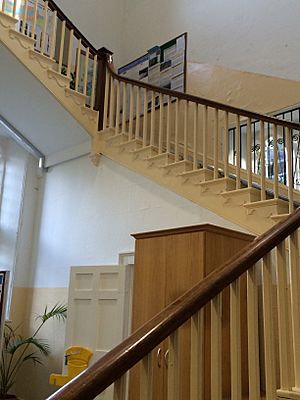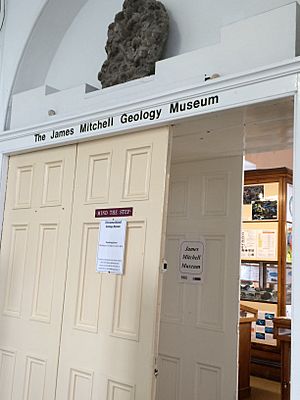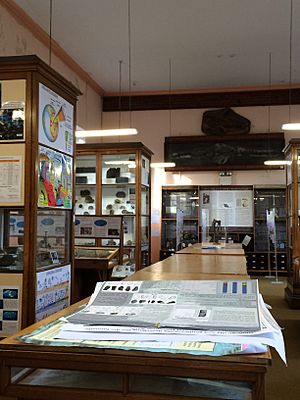James Mitchell Geology Museum facts for kids
| Músaem Geolaíocht Shéamuis Uí Mhistéala | |

Staircase ascending towards the James Mitchell Geology Museum
|
|
| Lua error in Module:Location_map at line 420: attempt to index field 'wikibase' (a nil value). | |
| Established | 1852 |
|---|---|
| Location | Galway, Ireland |
| Type | Geology |
| Collection size | 15,000 specimens |
The James Mitchell Geology Museum (Irish: Músaem Geolaíocht Shéamuis Uí Mhistéala) is a cool museum about rocks, minerals, and fossils. It's located at the University of Galway in the West of Ireland. This museum is a special part of what used to be the university's Natural History Museum. Some people call it "Galway's Hidden Museum" because it's tucked away in the university's Main Quad. You can find it by going up a staircase in the south-east corner of that building.
Contents
History of the Museum
How It Started
The museum first opened in 1852. It began with amazing collections from a geologist named William King. His collection included many rocks, minerals, and fossils. Over time, more items were added through trades, gifts, and purchases. The original lists of items made by King are still around today.
Changes Over Time
In 1883, Richard J. Anderson became a professor. He was in charge of Natural History, Geology, and Mineralogy. He decided to combine the geology and animal collections. This created a bigger Natural History Museum. At that time, the museum had five rooms. Three rooms were for animals, and two were for rocks, minerals, and fossils.
After Professor Anderson passed away, his job was split into two. One part was for Natural History, and the other was for Geology and Mineralogy. Later, during Professor Henry Cronshaw's time, the museum was divided. Only the geology collections stayed in their current spot.
Honoring Professor Mitchell
In 1921, Professor James Mitchell took over as the head of Geology and Mineralogy. He held this important job until 1966. During his many years, the museum's collection stayed together and was well cared for. In 1977, the museum was named in his honor. This was to recognize all the hard work Professor Mitchell did for the university.
Over the years, the collections sometimes needed extra care. The first big cleanup happened in 1975. The space was cleaned, redecorated, and the specimens were preserved. It's interesting to know that no new items were added to the collection between 1879 and 1975! The museum's items were preserved again in the 1990s. During this time, they also created a computer list of all the collections.
What You Can See Inside
Exploring the Collections
Today, the museum is in one large room. This room used to be the Geographical Museum. Inside, you'll find many different rocks, minerals, and fossils. These items are mainly used to help students and teachers at the University of Galway learn. But they are also a great resource for primary and secondary school children.
The museum has about 5,000 fossils and 3,000 rocks and minerals. These collections are very important for studying the geology of Ireland. The museum looks a lot like the Natural History Museum in Dublin. It has a "Victorian cabinet style," which means it looks like a museum from a long time ago.
Amazing Specimens
The collections were meant to show geology from all over the world. You can see examples from many different countries. The fossil collections include a plesiosaur from Lyme Regis in England. There's also a German ichthyosaur, which is another type of ancient marine reptile. You can also see ancient plants from the Kiltorcan Devonian flora found in County Kilkenny, Ireland.
More recently, the museum has added items from the Dave McDougall collection. This shows that the museum is now focusing on collecting more local specimens from Ireland.



